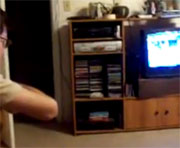
TUESDAY, Feb. 2 (HealthDay News) — Young children of Hispanic mothers whose main language is Spanish watch less TV than children of Hispanic moms who speak mostly English, a U.S. study has found.
Johns Hopkins Children’s Center researchers surveyed 1,332 Hispanic and white mothers with children aged 4 months to 3 years, and found that children of English-speaking Hispanic mothers watched nearly 2.5 hours of TV per day, compared to about 90 minutes for children of Spanish-speaking mothers.
The difference was especially pronounced in children older than 1 year. In this group, children in English-speaking Hispanic homes spent nearly 60 percent more time watching TV than children with Spanish-speaking mothers. This large difference wasn’t evident among children younger than 1 year of age.
The study also found that children aged 1 to 2 years with English-speaking Hispanic mothers spent nearly 60 percent more time watching TV than children of the same age with white mothers. By ages 2 and 3, children of white mothers and English-speaking Hispanic mothers watched about the same amount of TV, but children of Spanish-speaking mothers spent about 30 percent less time in front of the TV.
“Our findings show that what language mom speaks is a greater predictor than ethnicity alone of how much time a young child spends in front of the TV, a nuance that public health experts should recognize if they are to succeed in reducing TV time among these children,” lead investigator Dr. Darcy Thompson, a pediatrician at the Johns Hopkins Children’s Center, said in a news release.
The study findings are published in the February issue of the journal Archives of Pediatrics & Adolescent Medicine.
Children should have no more than one to two hours of cumulative exposure to TV and other media each day, including movies, Internet, video and computer games, according to the American Academy of Pediatrics.
More information
The American Academy of Pediatrics has more about children and TV.

